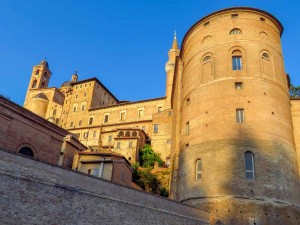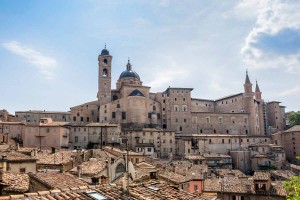
©Bigstock.com/Veniamin Kraskov
When it comes to Italy’s largest Renaissance centres, your first thought will probably be Florence, a world-famous city with equally world-famous buildings and pieces of art. However, this era of art and culture also blossomed rather fascinatingly outside of Tuscany. Urbino is a small, friendly town in the hills of the Marche. It saw a genuine building boom during the Montefeltro reign in the 15th century and adopted its Renaissance look which it still managed to retain to this very day. The historic centre was even declared UNESCO World Heritage Site in 1998.
Federico da Montefeltro’s influence
Having been sold to the pope after the Gothic Wars, the former Roman town Urbino repeatedly sought to become independent. Emperor Frederick I declared Antonio da Montefeltro imperial vicar of Urbino in 1155. His son Montefeltrano I became count, while Federico da Montefeltro even rose to the status of duke. Federico’s 38-year reign saw a genuine boom throughout the Duchy that left its mark on the town to this very day.
Being a very enterprising patron of the fine arts, Federico attracted some of the major Renaissance names of art and culture, such as Leon Battista Alberti, Piero della Francesca, Girolamo Genga, Luciano Laurana, Francesco di Giorgio Martini and Giovanni Santi, Raphael’s father. Bramante’s and Raphael’s artistic careers originally began in Urbino, too. The town’s architecture was moulded strongly after Renaissance ideals mostly keeping its classic look to this day due to economic stagnation after Federico’s death. His son Guidobaldo became the final duke of Urbino from the Montefeltro line. After his banishment around 1502, the della Rovere family assumed power until Urbino became part of the Papal States in 1631.
Palazzo Ducale
A brief walk through Urbino’s historic centre leads you to a great number of architectural highlights. To this very day, the former Ducal Palace of the Montefeltro line remains the town’s main attraction, and with good reason. Palazzo Ducale unites everything that makes the Renaissance town so unique in one phenomenal, magnificent building, its façade majestically looming high above Urbino virtually luring you to its historic centre.
Walls of a count’s palace, likely from the late 14th century, were used when constructions for this magnificent building began in 1463. Initial construction was slow until Federico da Montefeltro managed to win over the former Este master builder Luciano Laurana in 1466. He designed the pillar arcades in the atrium and the western tower façade. Francesco di Giorgio Martini took care of the interior fittings of the chambers. Fully stuccoed, high-ceilinged rooms and rich ornaments give the palazzo a distinctive Renaissance flair. The palace remained a government building deep into the 20th century before being opened to the public in the mid-1980s after extensive renovations.
Your tour through Palazzo Ducale will introduce you to the scholar Federico da Montefeltro. His interest in humanistic and classical studies is expressed in numerous rooms including the Studiolo, conceived by Laurana in 1472. Musical instruments, scientific devices and countless books grace this ideal of the educated Renaissance man. Additionally, we recommend stopping by Galleria Nazionale delle Marche. Various portraits of regents and the royal household aside, you’ll come across works by Raphael, Titian and Piero della Francesca.
Other Renaissance highlights in Urbino

©Bigstock.com/eddygaleotti
While your main focus understandably lies on the imposing Ducal Palace, Urbino’s historic Renaissance centre has so much more to offer. You should set aside at least one full day to extensively enjoy all aspects of the town. But where to go on your town walk, you wonder? Well, we might just have a few ideas for you:
- Duomo: Urbino’s history of building churches is long and illustrious, but also rather arduous and lined with setbacks. Federico da Montefeltro had the original Duomo, probably built in the early 11th century, replaced by an enormous new construction by di Giorgio Martini, which was only finished in 1602. Several earthquakes severely damaged the Duomo, particularly its cupola. The tomb of the humanist Polydor Vergil was lost irretrievably. Other parts of the building were restored in neoclassical style.
- University: Urbino’s university was founded only a few years after the banishment of Guidobaldo da Montefeltro. It is now privately owned with the various faculties being spread across several historic Renaissance buildings throughout the town centre. A trip to the botanical gardens “Pierina Scaramella” leads you to rare flowers and trees with a medicinal emphasis.
- Rampa Elicoidale: Federico da Montefeltro had an enormous staircase built to connect the market square with his palace. The old tower with its incredibly long, flat spiral stairs originally lead to a large theatre and is now mainly used for cultural events.
- San Domenico: This stunning church is located opposite Palazzo Ducale. You don’t even have to step inside San Domenico to be put under its spell, as its façade alone is pretty impressive. A Madonna with child and saints graces the richly adorned Renaissance gate. If you want to view Luca della Robbia’s original, you need to visit the Galleria Nazionale.
- Oratorio di San Giovanni Battista: Contrary to San Domenico, this small prayer chapel looks rather non-descript from the outside. However, you absolutely must sneak a peek inside these sacred halls to see the amazing late Gothic frescoes of the brothers Lorenzo and Jacopo Salimbeni depicting various scenes from the New Testament.
- Raphael’s Birthplace: As you already know, Raphael’s father Giovanni Santi was employed at Federico da Montefeltro’s court. His famous son was born in Urbino with his birthplace now being used as a museum exhibiting both copies of important works and originals (such as Giovanni Santi’s “Annunciation”). A tomb slab of Raphael’s parents is located on the side entrance of the San Francesco church.
Urbino’s historic centre has many other great palaces, churches and museums to offer – way too many to list them all. Set at least one full day aside for your journey through this stunningly beautiful Renaissance centre and take a few detours here and there into lesser known buildings. You’ll definitely be impressive by the diversity, the architectural beauty and the successfully cultivated charm of an era long gone. The ZAINOO team wishes you lots of fun with your Urbino tour!